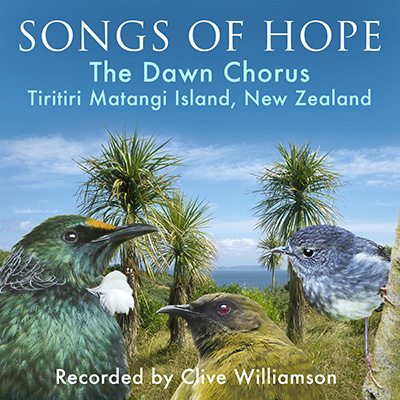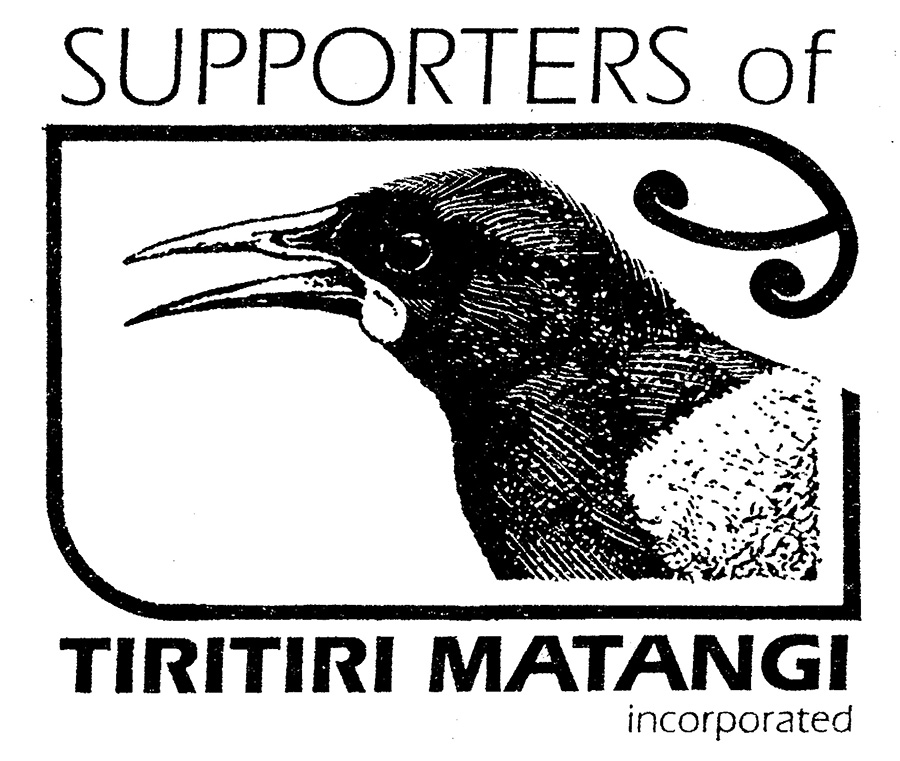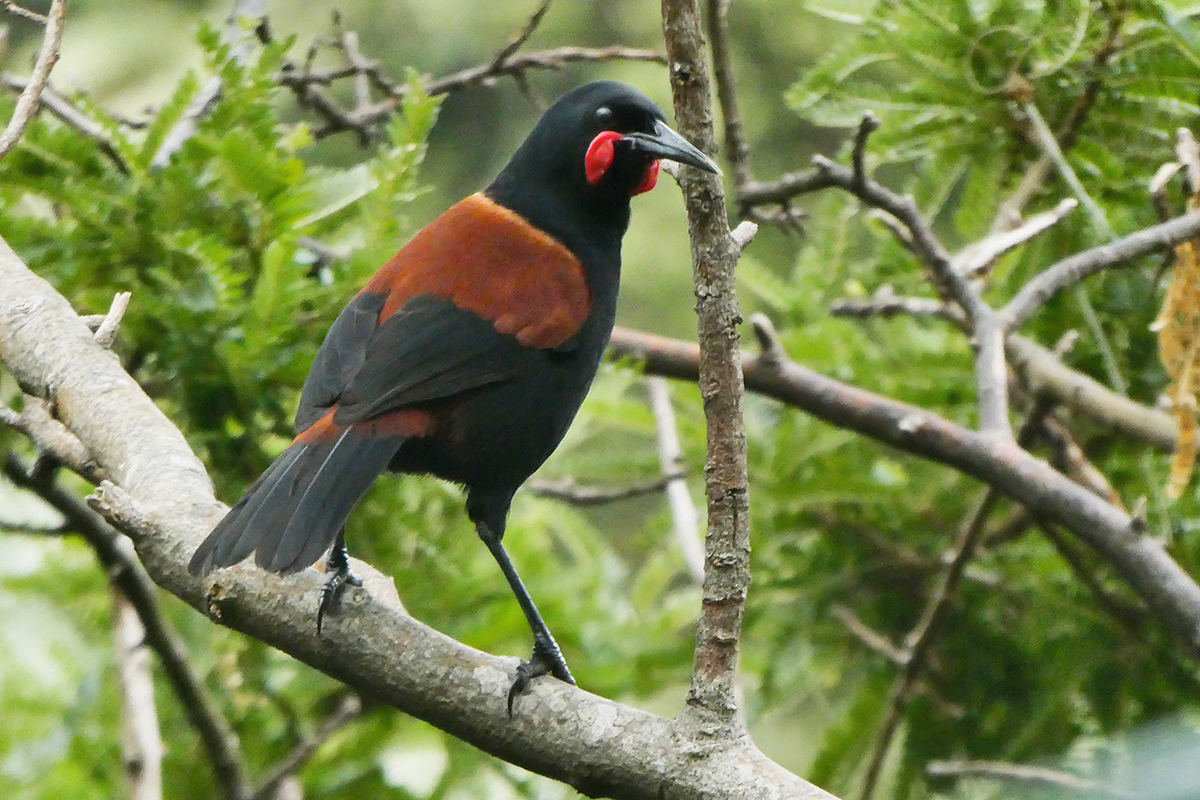Songs of Hope
The Dawn Chorus – Tiritiri Matangi Island, New Zealand
New Zealand’s endemic species are thriving on this off-shore Island Sanctuary in the Hauraki Gulf near Auckland.
A chorus of Tui, Korimako {North Island Bellbirds}, Popokotea {Whiteheads}, Tieke {Saddlebacks} and Hihi {Stitchbirds} sing in the continuously evolving concert of enchanting birdsong which can be heard each daybreak during the spring (on Tracks One to Four of this album). Tiritiri Matangi Island’s unique soundscape is a testament to all those New Zealanders who have worked so hard to restore the voices of the past to NZ’s landscape today.
Tiritiri Matangi Island is seen as a world-leading model for wildlife conservation. Through the sustained endeavours of New Zealand’s Department of Conservation, long-term residents (and D.O.C. rangers) Ray and Barbara Walter and the dedicated work of an army of willing “supporters of Tiritiri Matangi”, the numbers of endemic NZ bird species have grown to the point where hearing the island’s dawn chorus is now an amazingly rich sonic experience.

Songs of Hope
The Dawn Chorus – Tiritiri Matangi Island, New Zealand
New Zealand’s endemic species are thriving on this off-shore Island Sanctuary in the Hauraki Gulf near Auckland. A chorus of Tui, Korimako {North Island Bellbirds}, Popokotea {Whiteheads}, Tieke {Saddlebacks} and Hihi {Stitchbirds} sing in the continuously evolving concert of enchanting birdsong which can be heard each daybreak during the spring (on Tracks One to Four of this album). Tiritiri Matangi Island’s unique soundscape is a testament to all those New Zealanders who have worked so hard to restore the voices of the past to NZ’s landscape today.
Tiritiri Matangi Island is seen as a world-leading model for wildlife conservation. Through the sustained endeavours of New Zealand’s Department of Conservation, long-term residents (and D.O.C. rangers) Ray and Barbara Walter and the dedicated work of an army of willing “supporters of Tiritiri Matangi”, the numbers of endemic NZ bird species have grown to the point where hearing the island’s dawn chorus is now an amazingly rich sonic experience.

Songs of Hope
The Dawn Chorus – Tiritiri Matangi Island, New Zealand
New Zealand’s endemic species are thriving on this off-shore Island Sanctuary in the Hauraki Gulf near Auckland.
A chorus of Tui, Korimako {North Island Bellbirds}, Popokotea {Whiteheads}, Tieke {Saddlebacks} and Hihi {Stitchbirds} sing in the continuously evolving concert of enchanting birdsong which can be heard each daybreak during the spring (on Tracks One to Four of this album). Tiritiri Matangi Island’s unique soundscape is a testament to all those New Zealanders who have worked so hard to restore the voices of the past to NZ’s landscape today.

Tiritiri Matangi Island is seen as a world-leading model for wildlife conservation. Through the sustained endeavours of New Zealand’s Department of Conservation, long-term residents (and D.O.C. rangers) Ray and Barbara Walter and the dedicated work of an army of willing “supporters of Tiritiri Matangi”, the numbers of endemic NZ bird species have grown to the point where hearing the island’s dawn chorus is now an amazingly rich sonic experience.

It is probably the closest we can achieve today to the concert of birdsong encountered by botanist Joseph Banks when he visited New Zealand with Captain James Cook on the Endeavour in January 1770. He described being awoken by birds whose “voices were certainly the most melodious wild musick I have ever heard, almost imitating small bells but with the most tuneable silver sound imaginable.” 250 years later the air on Tiritiri Matangi is filled each morning with beautiful melodies and strange, haunting calls from Korimako {North Island Bellbirds}, Tui, Kokako and many others.
Track 5 eavesdrops on late Morning Birdsong on the island’s Kawerau Track (with Tui, Stitchbird, Kokako, NZ Robin, Saddleback) while Track 6 finds sound recordist and musician Clive Williamson playing autoharp to a relaxing backdrop of Bellbirds and Saddlebacks recorded on Tiritiri Matangi and a Tui from Kapiti Island near Wellington in 1995. (First released on “Aotearoa – Nature Sounds of New Zealand Extended Edition” by Symbiosis, 2017)
(Tracks 1-5 Recorded December 2017)

It is probably the closest we can achieve today to the concert of birdsong encountered by botanist Joseph Banks when he visited New Zealand with Captain James Cook on the Endeavour in January 1770. He described being awoken by birds whose “voices were certainly the most melodious wild musick I have ever heard, almost imitating small bells but with the most tuneable silver sound imaginable.” 250 years later the air on Tiritiri Matangi is filled each morning with beautiful melodies and strange, haunting calls from Korimako {North Island Bellbirds}, Tui, Kokako and many others.

Track 5 eavesdrops on late Morning Birdsong on the island’s Kawerau Track (with Tui, Stitchbird, Kokako, NZ Robin, Saddleback) while Track 6 finds sound recordist and musician Clive Williamson playing autoharp to a relaxing backdrop of Bellbirds and Saddlebacks recorded on Tiritiri Matangi and a Tui from Kapiti Island near Wellington in 1995. (First released on “Aotearoa – Nature Sounds of New Zealand Extended Edition” by Symbiosis, 2017)
(Tracks 1-5 Recorded December 2017)
“…the most melodious wild musick I have ever heard” Joseph Banks (Botanist, January 1770)
Listen to Songs of Hope:
Hear also the companion album of NZ nature sounds: New Zealand Naturally
Buy the Album ~ format: Digital Download
This album is available for download from our shop page. For other options, follow the links below.

